Experimental Investigation of Reflectarray Antennas for High-Power Microwave Applications
Abstract
1. Introduction
2. Design and Analysis of the HPM RA Elements
3. Fabrication and Measurement of the RAs
3.1. Directivity Testing under Low Power
3.2. Power Capacity Testing
3.3. Maximum Directivity Testing under High Power
4. Conclusions
Author Contributions
Funding
Data Availability Statement
Conflicts of Interest
References
- Swegle, J.; Schamiloulu, E.; Benford, J. High Power Microwaves, 2nd ed.; Taylor & Francis: Norwood, MA, USA, 2007. [Google Scholar]
- Gagnon, N.; Petosa, A. Using Rotatable Planar Phase Shifting Surfaces to Steer a High-Gain Beam. IEEE Trans. Antennas Propag. 2013, 61, 3086–3092. [Google Scholar] [CrossRef]
- Li, X.Q.; Liu, Q.X.; Wu, X.J.; Zhao, L.; Zhang, J.Q.; Zhang, Z.Q. A GW Level High-Power Radial Line Helical Array Antenna. IEEE Trans. Antennas Propag. 2008, 56, 2943–2948. [Google Scholar] [CrossRef]
- Yuan, C.W.; Peng, S.R.; Shu, T.; Li, Z.Q.; Wang, H. Designs and Experiments of a Novel Radial Line Slot Antenna for High-Power Microwave Application. IEEE Trans. Antennas Propag. 2013, 61, 4940–4946. [Google Scholar] [CrossRef]
- Rahmati, B.; Hassani, H.R. Low-Profile Slot Transmitarray Antenna. IEEE Trans. Antennas Propag. 2015, 63, 174–181. [Google Scholar] [CrossRef]
- Yang, Y.; Yuan, C.; Qian, B. A beam steering antenna for X-band high power applications. AEU—Int. J. Electron. Commun. 2014, 68, 763–766. [Google Scholar] [CrossRef]
- Guo, L.; Huang, W.; Chang, C.; Li, J.; Liu, Y.; Meng, R. Studies of a Leaky-Wave Phased Array Antenna for High-Power Microwave Applications. IEEE Trans. Plasma Sci. 2016, 44, 2366–2375. [Google Scholar] [CrossRef]
- Liu, Y.; Cheng, Y.J.; Lei, X.Y.; Kou, P.F. Millimeter-Wave Single-Layer Wideband High-Gain Reflectarray Antenna with Ability of Spatial Dispersion Compensation. IEEE Trans. Antennas Propag. 2018, 66, 6862–6868. [Google Scholar] [CrossRef]
- Jiang, P.; Jiang, W.; Gong, S. A Mesh-Type Low RCS Reflectarray Antenna Based on Spoof Surface Plasmon Polariton. IEEE Antennas Wirel. Propag. Lett. 2021, 20, 224–228. [Google Scholar] [CrossRef]
- Malfajani, R.S.; Atlasbaf, Z. Design and Implementation of a Broadband Single Layer Circularly Polarized Reflectarray Antenna. IEEE Antennas Wirel. Propag. Lett. 2012, 11, 973–976. [Google Scholar] [CrossRef]
- Su, T.; Yi, X.; Wu, B. X/Ku Dual-Band Single-Layer Reflectarray Antenna. IEEE Antennas Wirel. Propag. Lett. 2019, 18, 338–342. [Google Scholar] [CrossRef]
- Gao, Q.; Wang, J.; Li, Y.; Li, Z. A Multiresonant Element for Bandwidth Enhancement of Circularly Polarized Reflectarray Antennas. IEEE Antennas Wirel. Propag. Lett. 2018, 17, 727–730. [Google Scholar] [CrossRef]
- Kong, G.; Li, X.; Wang, Q.; Zhang, J. A Dual-Band Circularly Polarized Elliptical Patch Reflectarray Antenna for High-Power Microwave Applications. IEEE Access. 2021, 9, 74522–74530. [Google Scholar] [CrossRef]
- Kong, G.; Li, X.; Wang, Q.; Zhang, J. A Wideband Reconfigurable Dual-Branch Helical Reflectarray Antenna for High-Power Microwave Applications. IEEE Trans. Antennas Propag. 2021, 69, 825–833. [Google Scholar] [CrossRef]
- Zhao, X.; Bi, S.; Zhang, Q.; Sun, Y.; Zhang, J.; Yuan, C. An All-Metal, Circularly Polarized Reflectarray Antenna for High-Power Microwave Applications. IEEE Trans. Plasma Sci. 2022, 50, 3525–3528. [Google Scholar] [CrossRef]
- Bi, S.; Xu, L.; Cheng, X.; Sun, Y.; Zhang, Q.; Yuan, C. An All-Metal, Simple-Structured Reflectarray Antenna with 2-D Beam-Steerable Capability. IEEE Antennas Wirel. Propag. Lett. 2023, 22, 129–133. [Google Scholar] [CrossRef]
- Li, X.Q.; Liu, Q.X.; Zhang, J.Q.; Zhao, L. 16-Element Single-Layer Rectangular Radial Line Helical Array Antenna for High-Power Applications. IEEE Antennas Wirel. Propag. Lett. 2010, 9, 708–711. [Google Scholar] [CrossRef]
- Mei, P.; Zhang, S.; Pedersen, G.F. A Low-Cost, High-Efficiency and Full-Metal Reflectarray Antenna with Mechanically 2-D Beam-Steerable Capabilities for 5G Applications. IEEE Trans. Antennas Propag. 2020, 68, 6997–7006. [Google Scholar] [CrossRef]
- Zhao, J.; Li, H.; Li, T. Design of a double square rings element for high-power X-band reflectarray antenna. In Proceedings of the 2015 IEEE International Vacuum Electronics Conference (IVEC), Beijing, China, 27–29 April 2015. [Google Scholar]
- Zhao, X.H.; Xu, L.; Zhang, J.D.; Yuan, C.W.; Zhang, Q.; Sun, Y.F. A dielectric embedded reflectarray for high-power microwave application. Rev. Sci. Instrum. 2022, 93, 064703. [Google Scholar] [CrossRef] [PubMed]
- Li, X.; Zhou, Z.; Wang, Q.; Zhang, J. A Polarization Conversion Radome for High-Power Microwave Applications. IEEE Antennas Wirel. Propag. Lett. 2019, 6, 1096–1099. [Google Scholar] [CrossRef]
- Pan, X.; Christodoulou, C.G.; Lawrance, J.; McConaha, J.; Landavazo, M. Cold & hot tests of an S-band antenna for high power microwave systems. In Proceedings of the 2017 IEEE International Symposium on Antennas and Propagation & USNC/URSI National Radio Science Meeting, San Diego, CA, USA, 9–14 July 2017. [Google Scholar]
- Zahran, S.R.; Elshafey, A.F.; Abdalla, M.A. High Gain Wideband Air Strip-Line Fed Antenna For High Power Applications. In Proceedings of the 2019 IEEE International Symposium on Antennas and Propagation and USNC-URSI Radio Science Meeting, Atlanta, GA, USA, 7–12 July 2019. [Google Scholar]
- Yan, F.; Liu, M.; Zhuang, Q.; Bai, W.; Xiong, Z.; Yan, C.; Jiang, T. Receiving Device for X-band High-Power Microwave Measurement Based on OMT. In Proceedings of the 2019 IEEE 2nd International Conference on Electronics Technology (ICET), Chengdu, China, 10–13 May 2019. [Google Scholar]
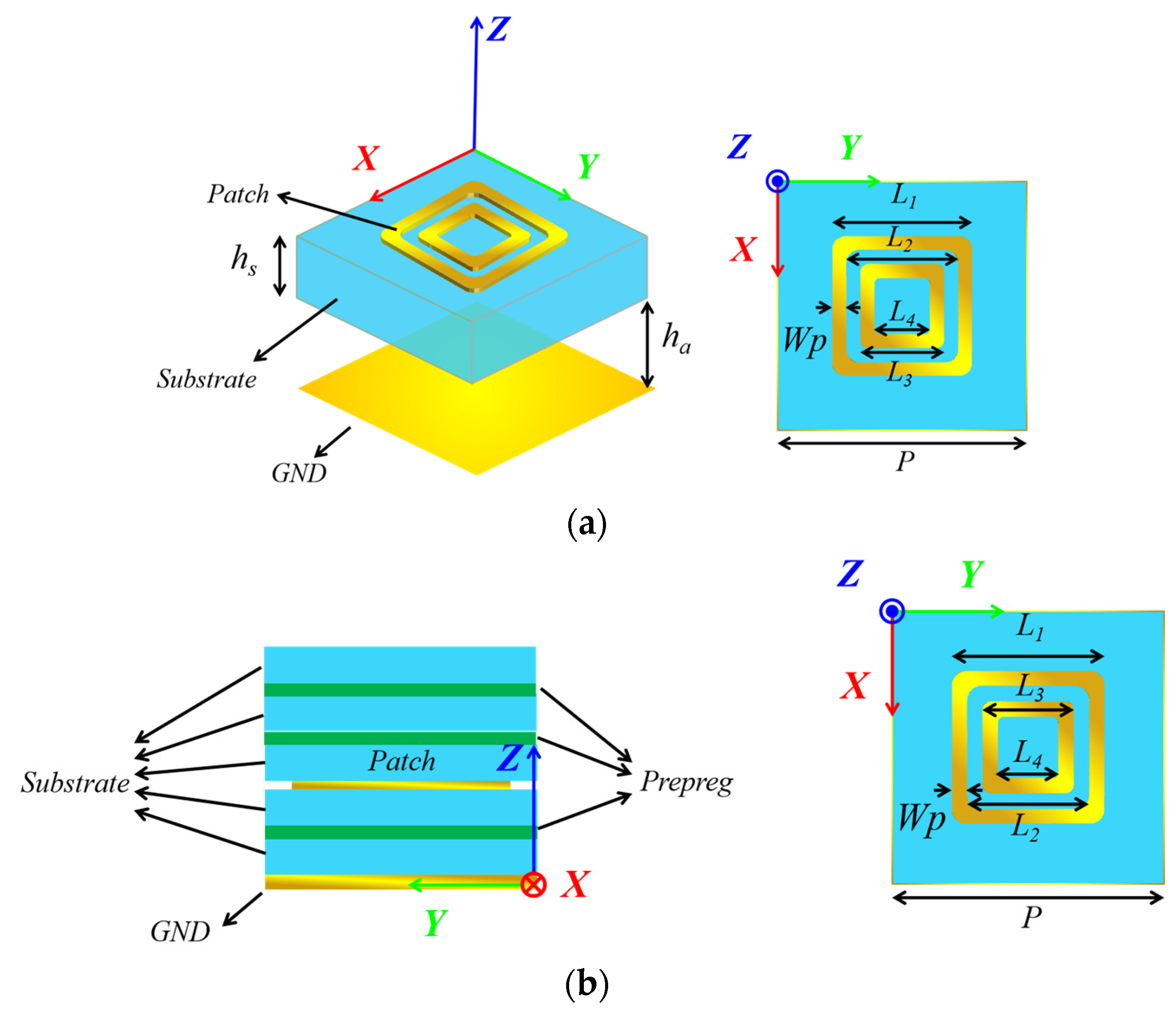
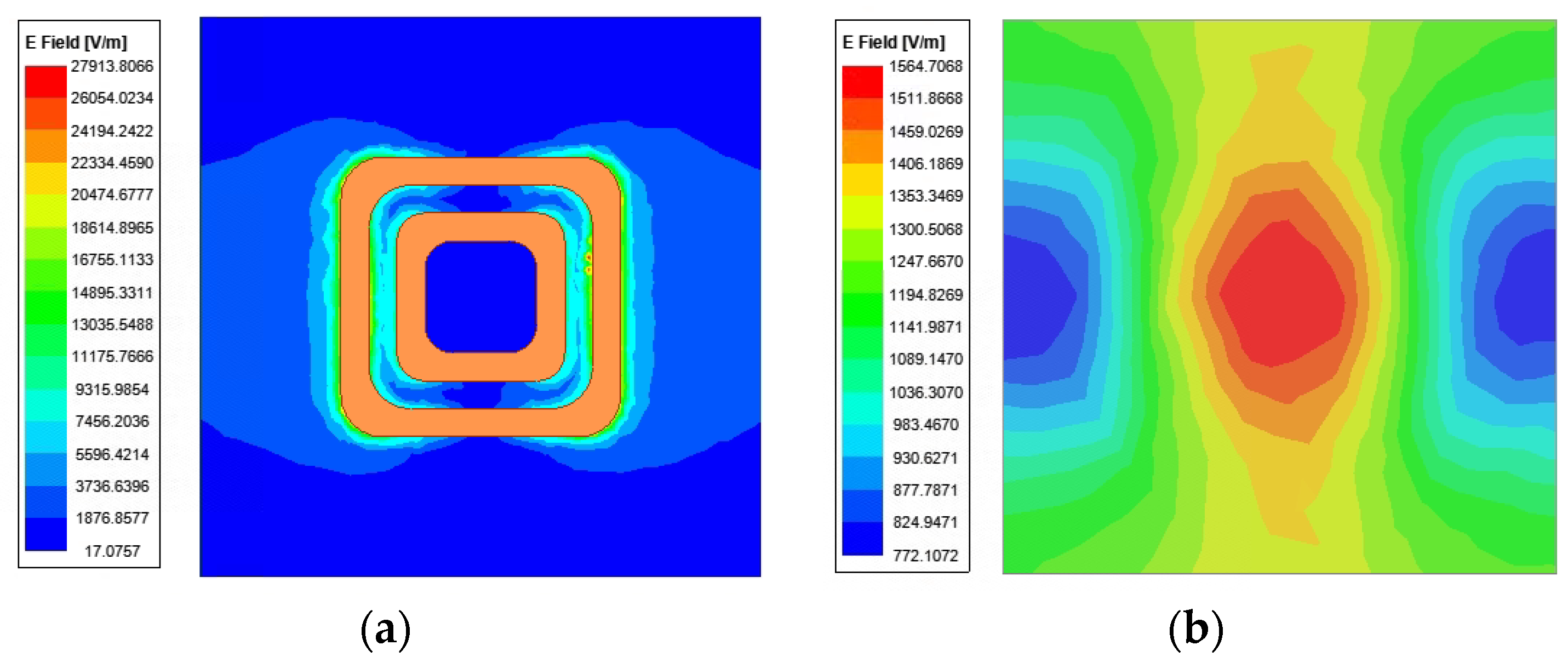
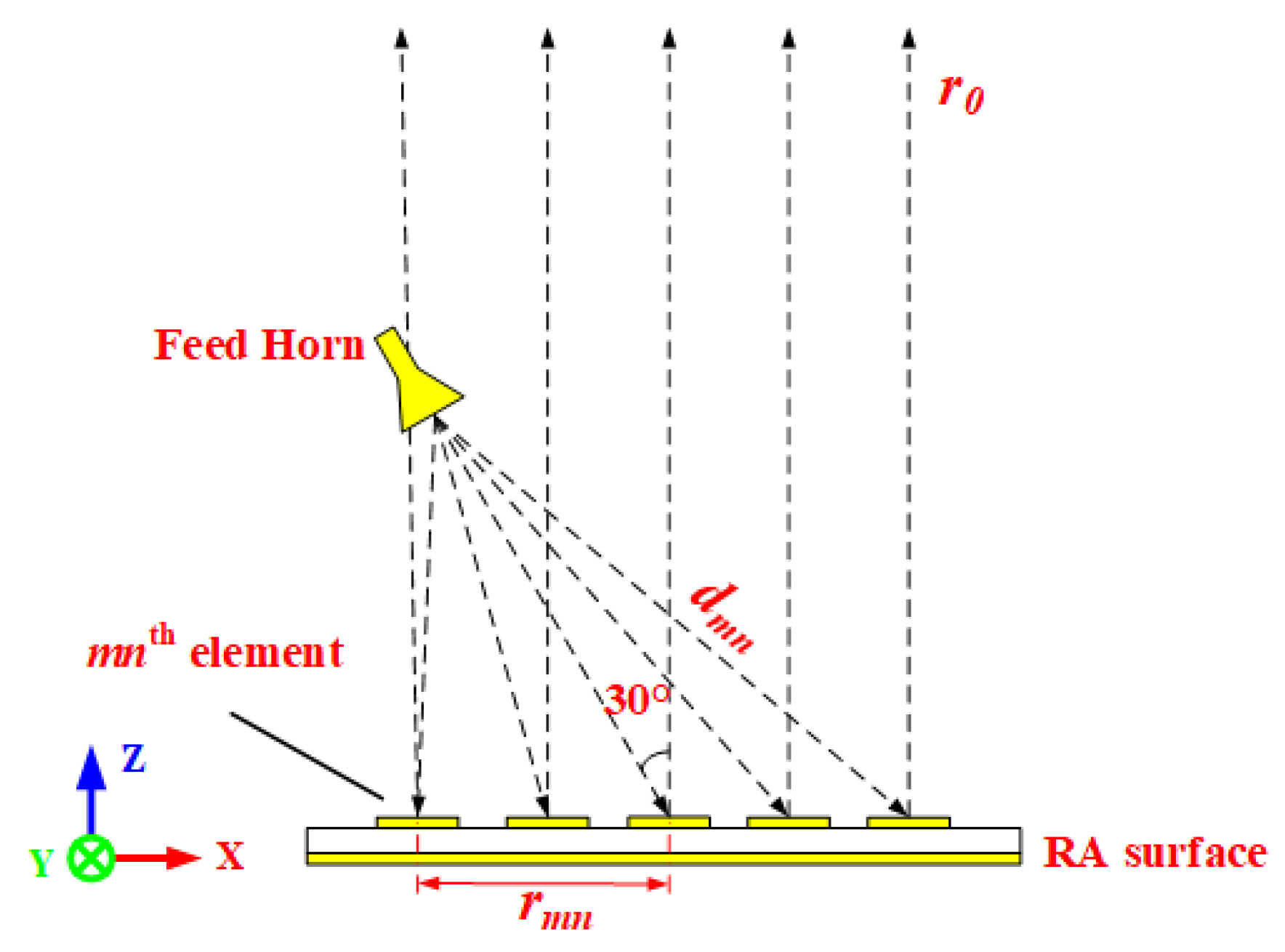
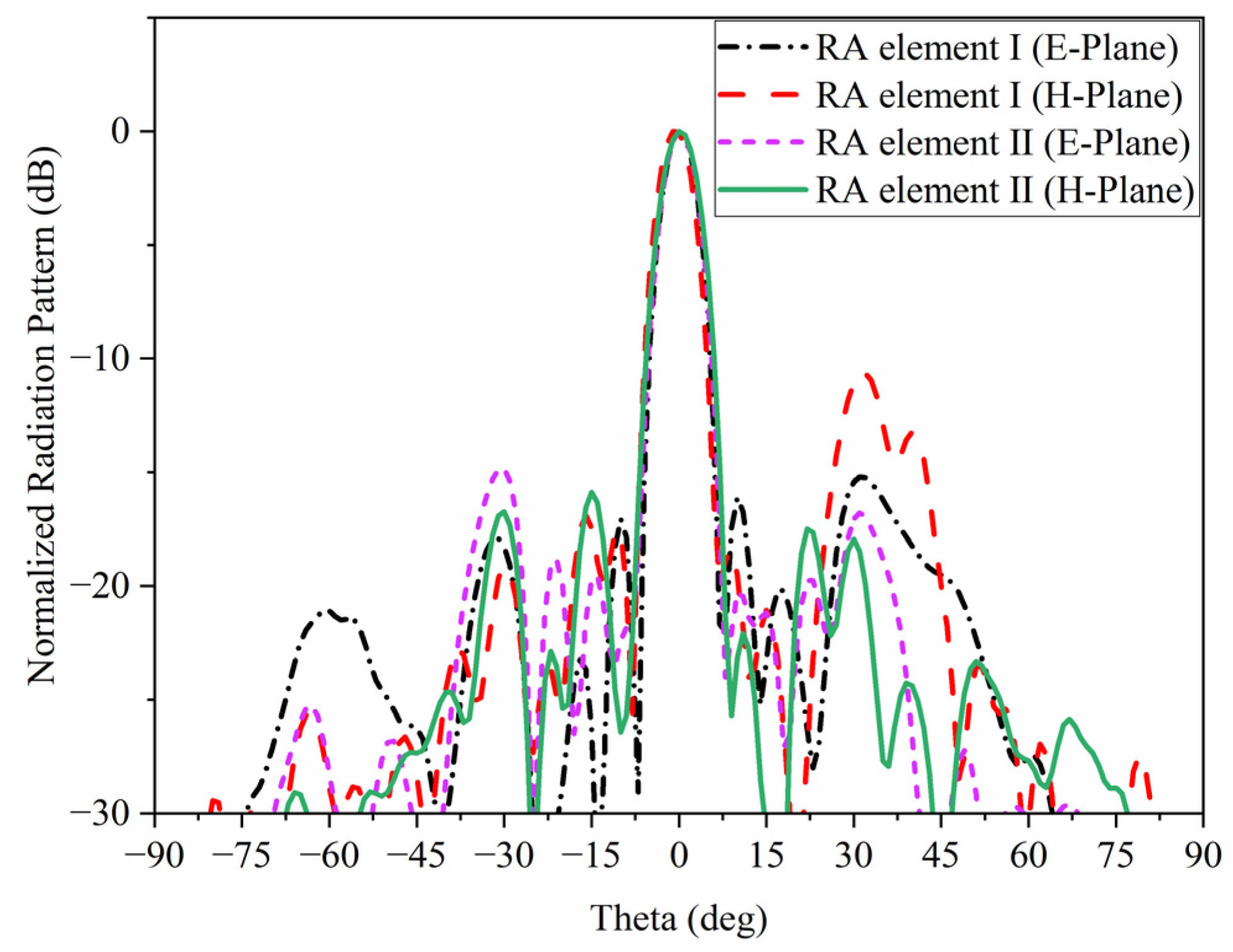

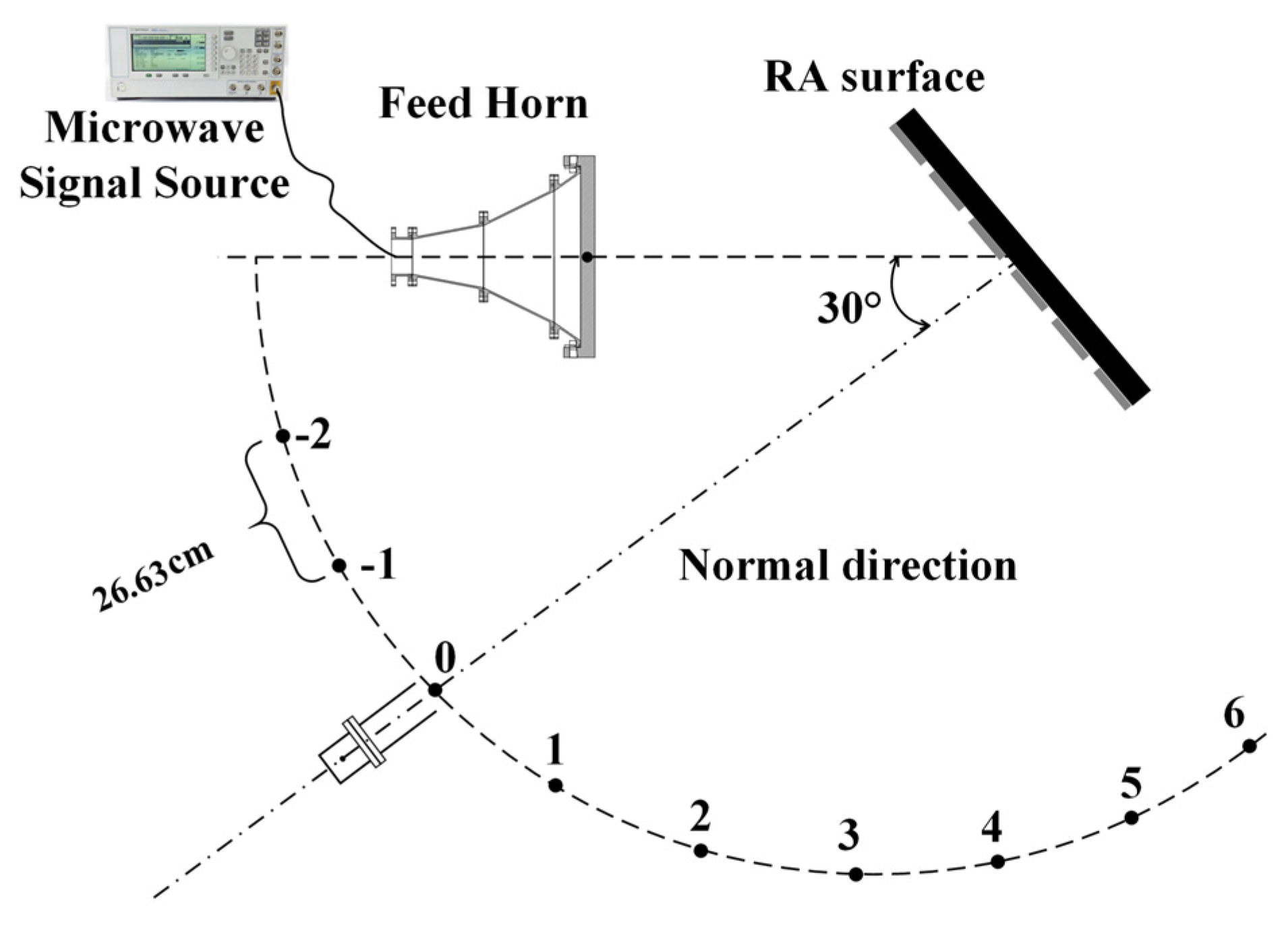
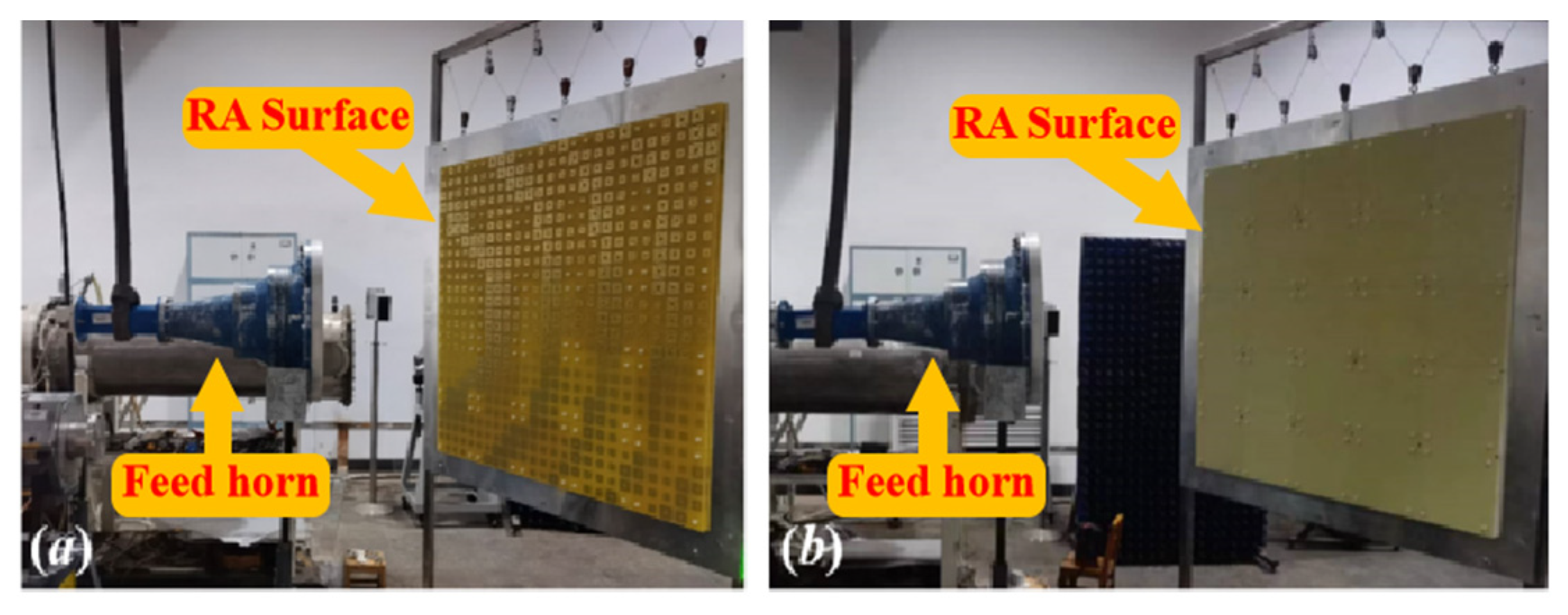
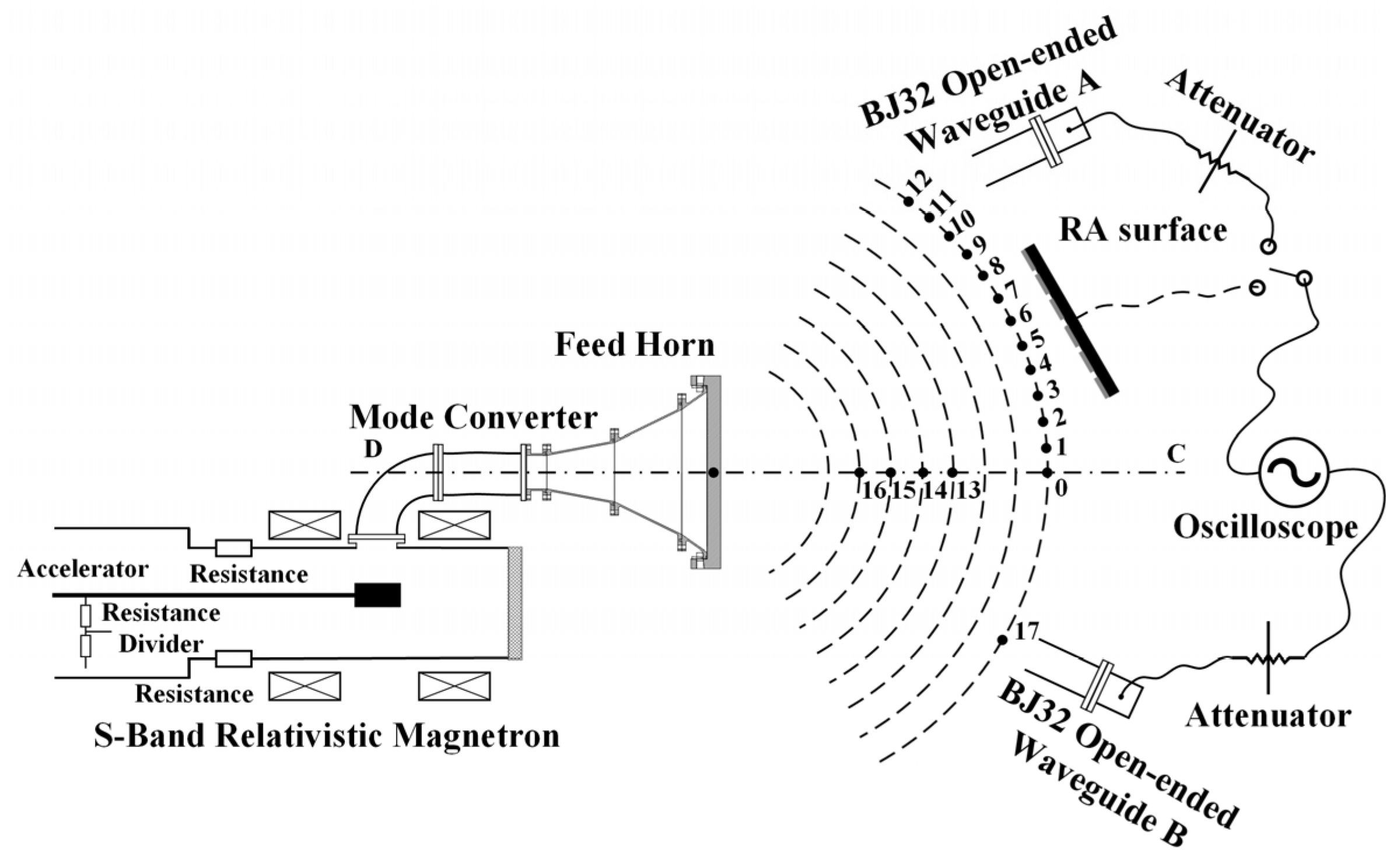

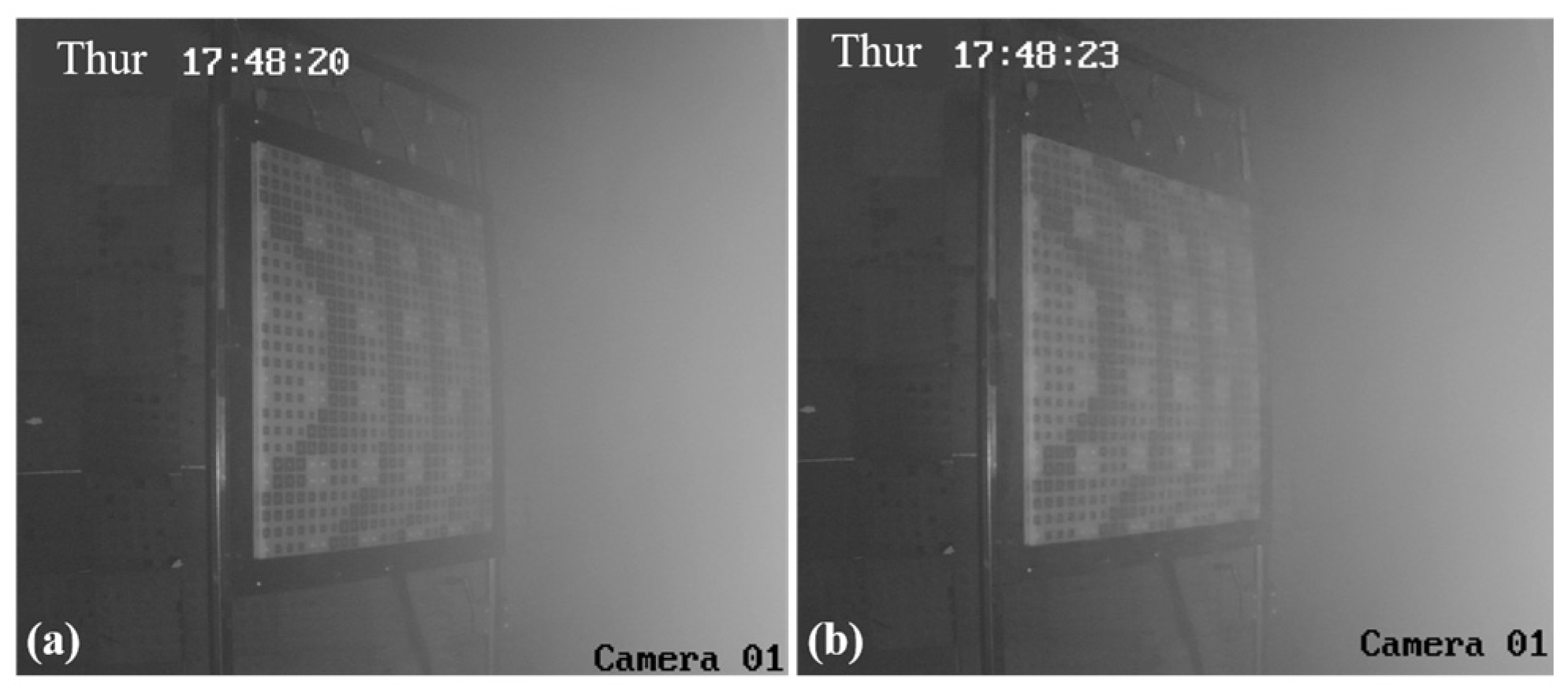
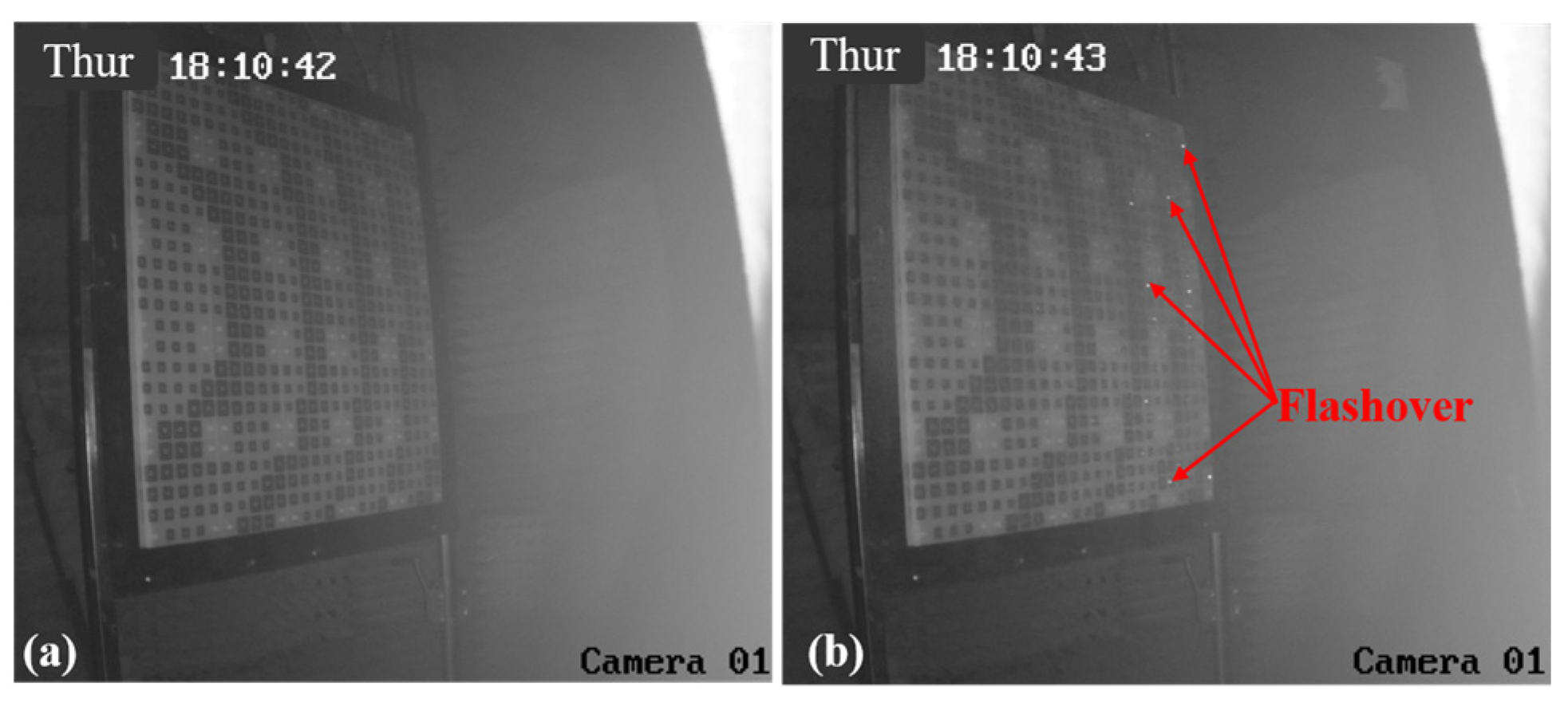

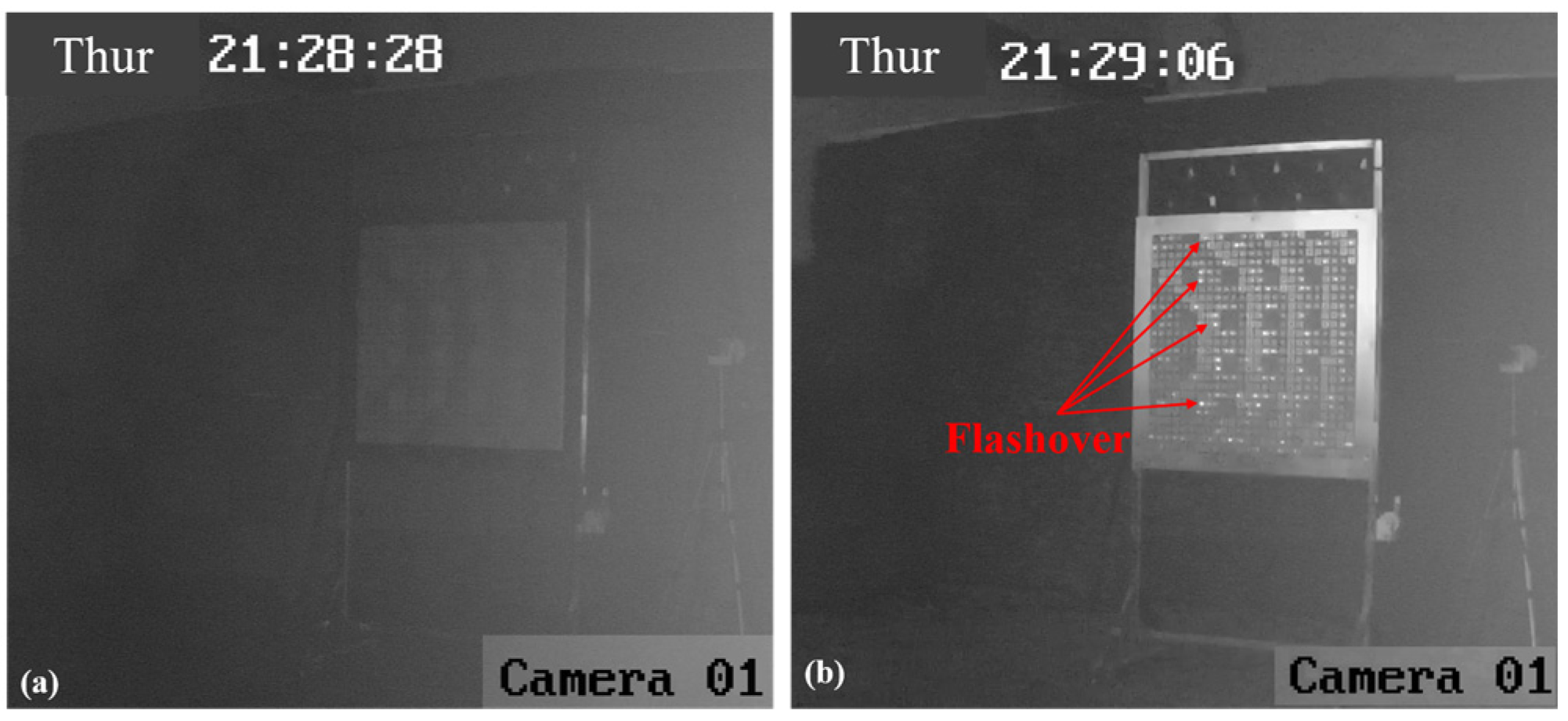
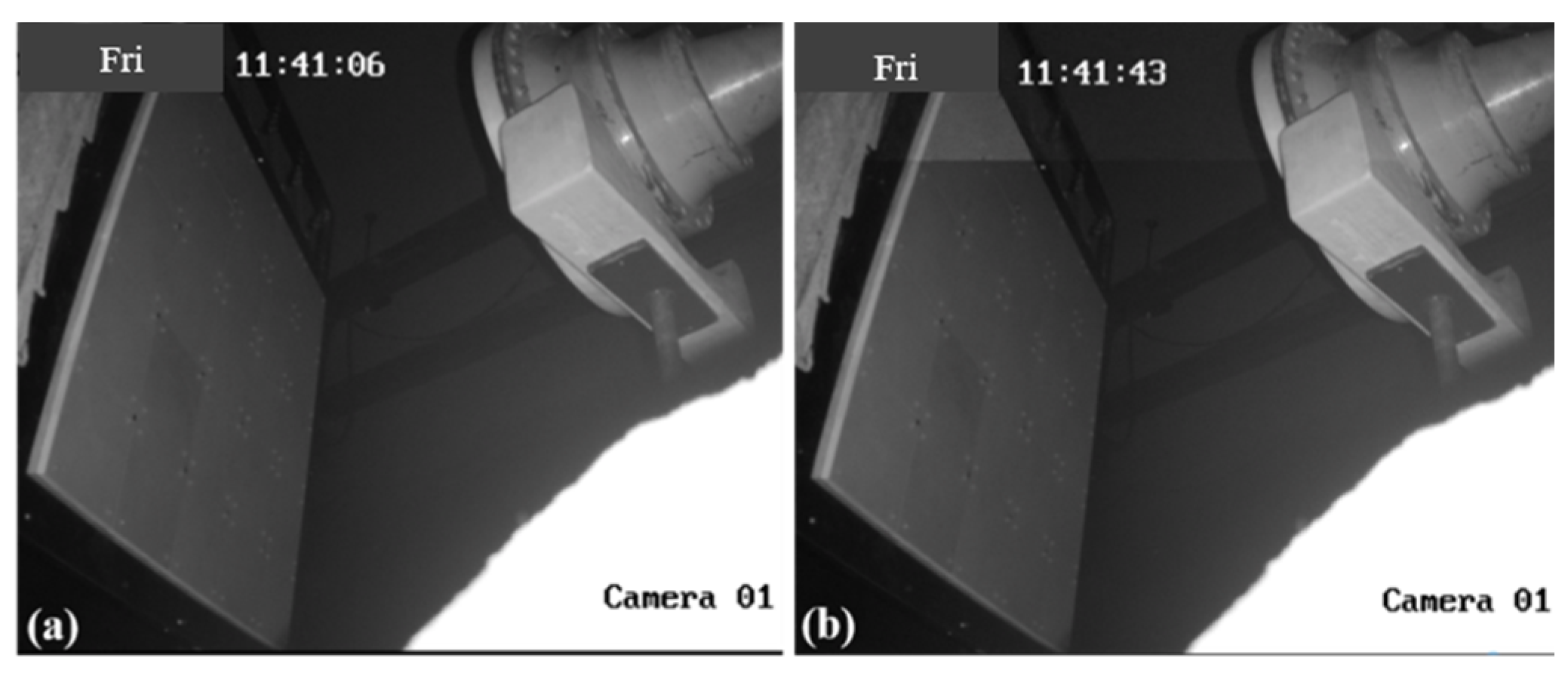
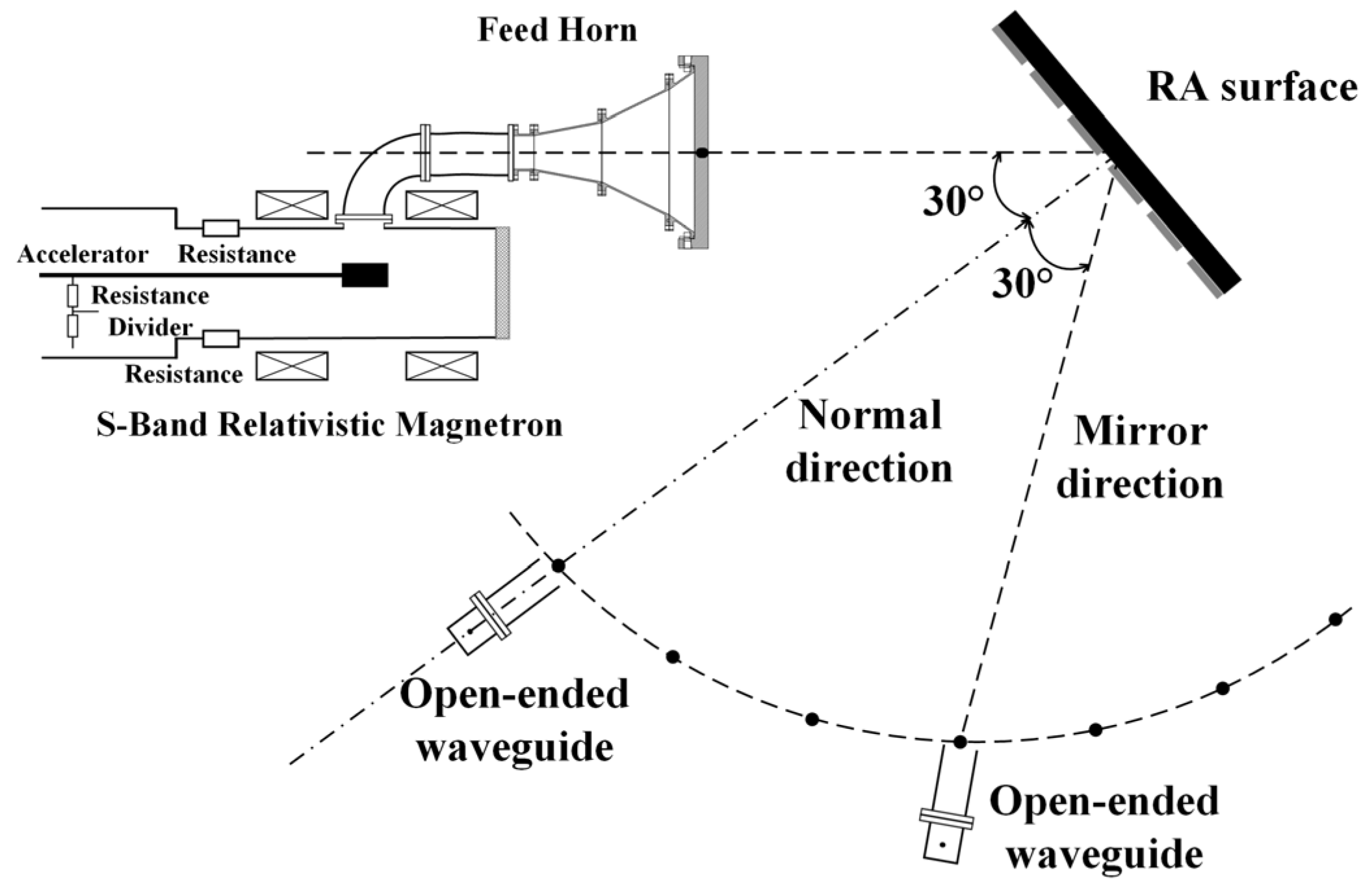
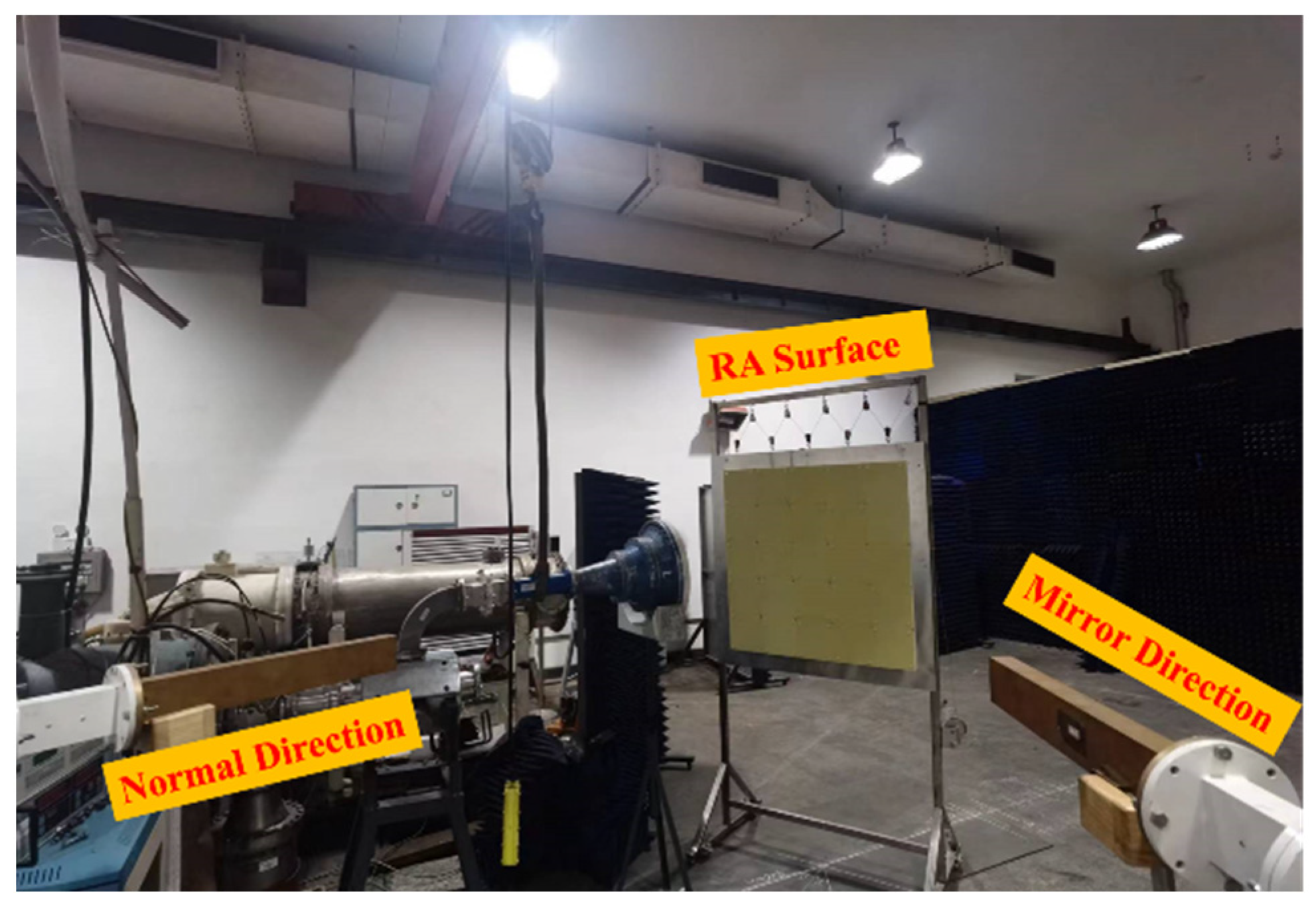
| Testing Position | Angle Information (deg) | RA with Element I (dBm) | RA with Element II (dBm) |
|---|---|---|---|
| #−1 | 10 | −35.46 | −34.15 |
| #0 | 0 | −23.3 | −22.1 |
| #1 | 10 | −29.7 | −28.53 |
| #2 | 20 | −30.3 | −29.02 |
| #3 | 30 | −34.7 | −28.9 |
| #4 | 40 | −36.8 | −31.24 |
| #5 | 50 | −44.2 | −33.64 |
| #6 | 60 | −54.1 | −42.3 |
| Reference Position | Angle Information (deg) | Distance between Each Position and Position #0 (m) | The Voltage of the Open-Ended Waveguide B(V) | The Voltage of the Open-Ended Waveguide A(V) | The Power Density of the Open-Ended Waveguide A Pd (W/cm2) |
|---|---|---|---|---|---|
| #0 | 0 | 0 | 0.612 | 2.91 | 24,412 |
| #1 | 5 | 0.44 | 0.6332 | 2.66 | 21,067 |
| #2 | 10 | 0.87 | 0.628 | 2.63 | 19,800 |
| #3 | 15 | 1.31 | 0.64 | 2.11 | 13,440 |
| #4 | 20 | 1.74 | 0.52 | 1.63 | 7748 |
| #5 | 25 | 2.16 | 0.53 | 1.34 | 5236 |
| #6 | 30 | 2.59 | 0.61 | 1.26 | 4556 |
| #7 | 35 | 3.01 | 0.57 | 1.08 | 3473 |
| #8 | 40 | 3.42 | 0.57 | 0.93 | 2575 |
| #9 | 45 | 3.83 | 0.51 | 0.64 | 730 |
| #10 | 50 | 4.23 | 0.54 | 0.53 | 810 |
| #11 | 55 | 4.62 | 0.61 | 0.426 | 511 |
| #12 | 60 | 5 | 0.61 | 0.272 | 210 |
| #13 | - | 1.8 | 0.62 | 4.345 | 54,200 |
| #14 | - | 2.4 | 0.61 | 5.146 | 77,200 |
| #15 | - | 3 | 0.58 | 5.401 | 85,000 |
| #16 | - | 3.6 | 0.592 | 6.044 | 106,505 |
Disclaimer/Publisher’s Note: The statements, opinions and data contained in all publications are solely those of the individual author(s) and contributor(s) and not of MDPI and/or the editor(s). MDPI and/or the editor(s) disclaim responsibility for any injury to people or property resulting from any ideas, methods, instructions or products referred to in the content. |
© 2024 by the authors. Licensee MDPI, Basel, Switzerland. This article is an open access article distributed under the terms and conditions of the Creative Commons Attribution (CC BY) license (https://creativecommons.org/licenses/by/4.0/).
Share and Cite
Zhao, J.; Dong, Y.; Li, H.; Li, T.; Liu, W.; Zhou, Y.; Wang, H.; Hu, B.; Li, F.; Wang, K.; et al. Experimental Investigation of Reflectarray Antennas for High-Power Microwave Applications. Micromachines 2024, 15, 399. https://doi.org/10.3390/mi15030399
Zhao J, Dong Y, Li H, Li T, Liu W, Zhou Y, Wang H, Hu B, Li F, Wang K, et al. Experimental Investigation of Reflectarray Antennas for High-Power Microwave Applications. Micromachines. 2024; 15(3):399. https://doi.org/10.3390/mi15030399
Chicago/Turabian StyleZhao, Jianing, Yongzhen Dong, Hao Li, Tianming Li, Wei Liu, Yihong Zhou, Haiyang Wang, Biao Hu, Fang Li, Keqiang Wang, and et al. 2024. "Experimental Investigation of Reflectarray Antennas for High-Power Microwave Applications" Micromachines 15, no. 3: 399. https://doi.org/10.3390/mi15030399
APA StyleZhao, J., Dong, Y., Li, H., Li, T., Liu, W., Zhou, Y., Wang, H., Hu, B., Li, F., Wang, K., & Qiu, B. (2024). Experimental Investigation of Reflectarray Antennas for High-Power Microwave Applications. Micromachines, 15(3), 399. https://doi.org/10.3390/mi15030399





